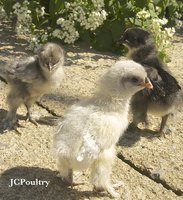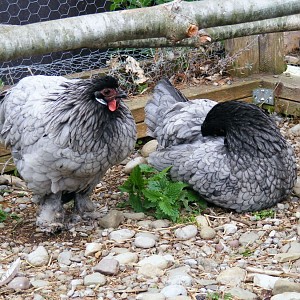General Information
- Breed Purpose
- Dual Purpose
- Egg Productivity
- Medium
- Egg Size
- Medium
- Egg Color
- White
- Breed Colors/Varieties
- Black/Blue/Splash in USA, Others in Europe
- Breed Size
- Large Fowl
Bredas, Grueldres, Grueldrelands, Guelderlands, Gueldres and Kraaikops
by
Craig Russell
RR 4 Box 251
Middleburg, PA 17842
with permission from
SPPA Bulletin, 2001, 6(2):9
A caller recently expressed his opinion that the Breda was an interesting fowl and wondered why they never made it to America. I've had similar conversations over the years. Since this is a breed with unique characteristics and one with a rather extensive American history, it bears a closer look. The Breda never made it into the APA standard. The primary reason it is poorly remembered in North America has to do with a confusion of names. Those listed in the title are all synonyms for the same bird. To my knowledge, the breed does not currently exist in the U.S. [6/7/2012 up-date, This breed was recently imported from Europe by Greenfire Farms]
Although usually considered a Dutch breed, the Breda may be French in origin. The Dutch call the breed Kraaikops, leading some English writers to confuse it with the Kraienkopp (Kraienkoppe for English speakers). The other names, including a few that I didn't mention, are based on the region of Holland where it was most common and where most experts believe it originated.
Prior to the Civil War, the Breda was a fairly common breed in the U.S., where they were usually called Guelderlands or sometimes Guelders. As recently as 1867, Solon Robinson in the poultry section of his book, Wisdom of the Land, mentions them as a common breed. Leghorns, imported in the 1830s, were still not important enough to be mentioned by Robinson. He considered Dorkings the best practical fowl. He also liked Games, Dominiques, Jersey Blues and Javas for everyday purposes. For egg production he favored Spanish and Polish and mentioned the Hamburg group favorably. He praised the Guelderlands as being plump, but did not consider them good layers or sitters. His opinion of their laying ability differs with that of most European writers who generally considered them to be prolific producers.
The Guelderlands were to a considerable extent displaced by early Asiatic imports in the U.S. Following the Civil War the great explosion of American produced breeds nearly swept them completely from public notice. They experienced a considerable decline in Europe at the same time, but in the early 1900s began to recover both as a show fowl and in economic importance. This led to additional American imports, but they never obtained a long term following.
Robinson and most other early writers mention them only as a black fowl. Most 20th century imports were Cuckoo, but a limited number of blue and white Bredas were present also. The term Breda probably was not in use in North America until after 1900.
The Breda is a rather large bodied fowl, with a well-developed prominent breast, strong thighs, rather long closely feathered legs, vulture hocks, broad slightly sloping back, short well arched neck, long strong head with a stout well curved beak and no comb. A tassel or small tuft of feathers (usually very small) rises from the head at the rear of the flat depressed area where the comb should be. Bredas also have large cavernous nostrils as are usually found in crested breeds such as Polish or breeds with crested ancestry such as LaFleche.
The Breda is generally conceded to be a composite breed, but a rather early one. As far as I know, no definite records exist as to how it was produced. That it has some crested ancestry is obvious. I've mentioned that it is considered a Dutch breed, but minority opinions argue for a Belgian or French origin. The Malines is often mentioned as a probable ancestor and certainly would account for the feathered legs. That leaves us without a ready explanation for the vulture hocks. I've heard suggestions that Sultans crossed with Malines or Asiatics could have produced them, but this is a fowl that developed long before any Sultans or most Asiatics appeared in Western Europe.
The Breda was certainly the common fowl of Northern Holland. Even after it was to some extent displaced it was popular for the production of market hybrids. Dutch breeders commonly crossed it with Cochins in the later years of the 19th century. In France it was generally crossed with Crevecoeurs, Houdans and Five toed fowl. Given what we know about the long use of both Polish and Malines to produce hybrids in that part of the world, it is likely that the Bredas themselves developed from such fowl. Individuals with the unusual and probably at the time very rare traits of vulture hocks and no combs were selected for a new breed.
To my knowledge the no comb characteristic is unique to this breed. That alone might recommend Bredas as a future SPPA importation project.
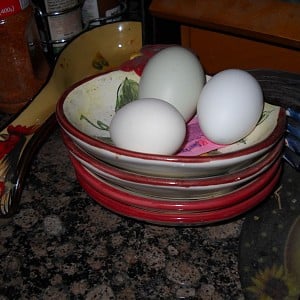
Breda eggs
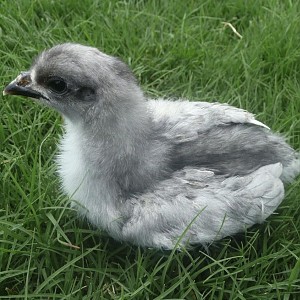
Breda chick
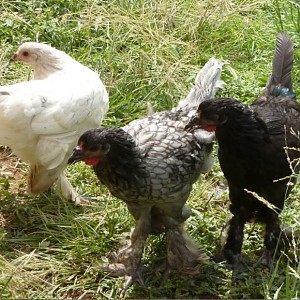
Breda juveniles
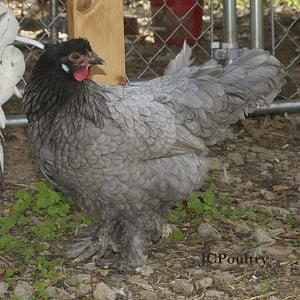
Breda hen
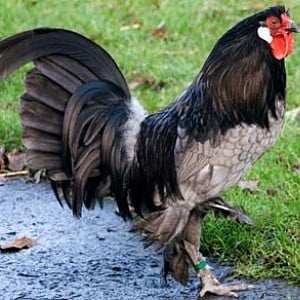
Breda rooster
For more information on this breed and their owners' and breeders' experiences with them, see our breed discussion here: https://www.backyardchickens.com/threads/breda-fowl-thread.561974/


